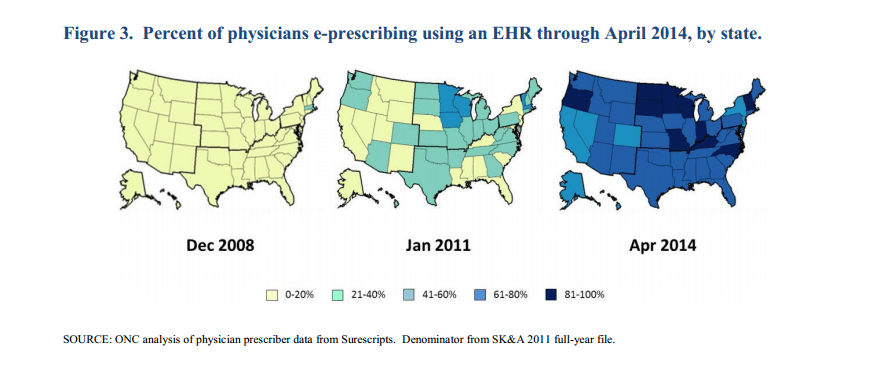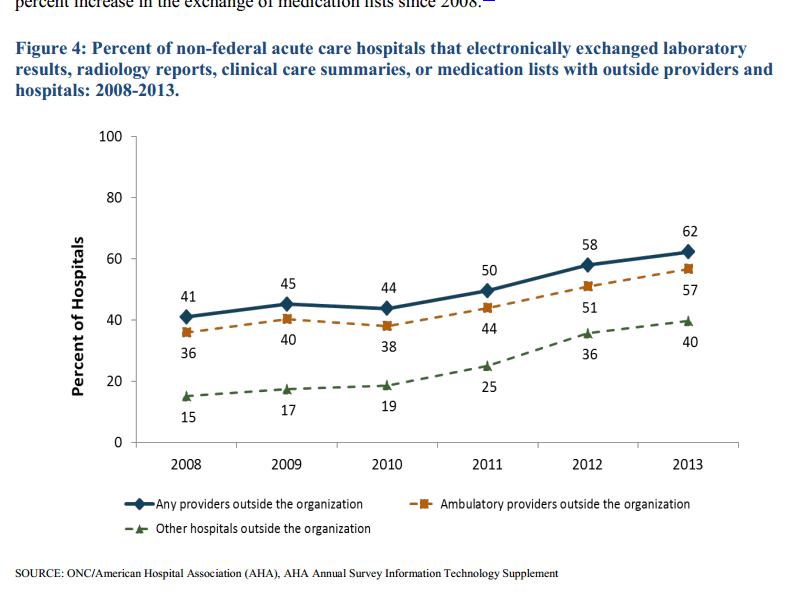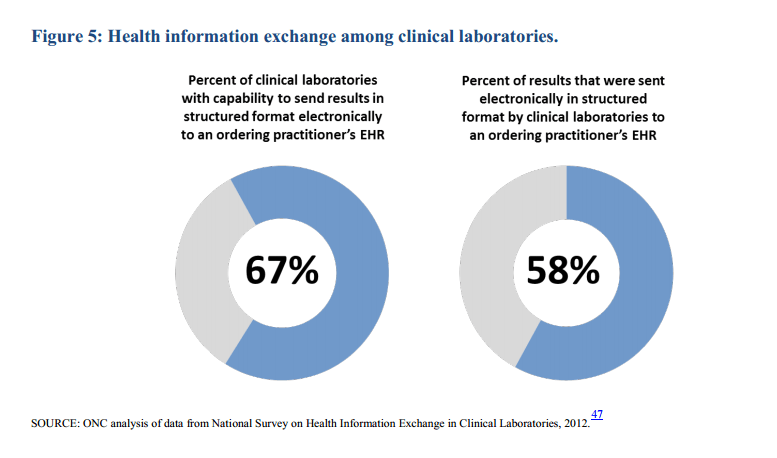Earlier this month, the ONC and HHS submitted their annual report to Congress highlighting the progress and accomplishments advancing health IT adoption. Driven by the HITECH Act passed in 2009, there has been significant advancements in health IT adoption among providers.
Here are 36 positive signs of health IT adoption progress highlighted in the report:
1. In 2013, 59 percent of hospitals and 48 percent of physicians had at least a basic EHR system, respective increases of 47 percentage points and 26 percentage points since 2009, the year the HITECH Act was signed into law.
Moreover, there is widespread participation among eligible hospitals and professionals in the CMS EHR Incentive Programs (EHR Incentive Programs).
2. As of June 2014, 75 percent (403,000+) of the nation’s eligible professionals and 92 percent (4,500+) of eligible hospitals and CAHs had received incentive payments.
Physician Adoption of EHR Technology
Results from a 2013 nationally representative survey of office-based physicians indicate that:
3. More than three-quarters (78 percent) used any type of EHR system, up from 18 percent in 2001.
4. About one-half (48 percent) reported having a system that met the criteria for a basic EHR system, up from 11 percent in 2006.
5. When limited to primary care physicians, more than one-half (53 percent) of such office-based physicians reported having a system that meets the criteria for a basic EHR system.
RECs (Regional Extension Centers)
6. As of June 2014, RECs assist over 150,000 providers, of which over 136,000 are now live on an EHR, and over 100,000 have achieved meaningful use through the EHR Incentive Programs.
7. RECs are partnered with over 46 percent of all primary care providers in the nation, 54 percent of all rural providers, 83 percent of all community health centers, and 80 percent of all Critical Access Hospitals.
8. An October 2013 Government Accountability Office (GAO) report found that Medicare providers working with RECs were nearly twice as likely to receive Medicare EHR Incentive Payments as those that do not.
9. Collectively, the RECs will assist at least 10,000 specialists and primary care providers not eligible for the EHR Incentive Programs, such as nurse practitioners, physician assistants, and other providers from certain specialty settings. The program ends August 2015.
Rural Community Support
10. From 2011-2014, HRSA’s Office of Rural Health Policy awarded one- time funding of $12 million to 41 grantees for the Rural Health IT Network Development Program to enhance health care delivery in rural America.
11. In 2013, HHS and the U.S. Department of Agriculture (USDA) launched a pilot project to expand access to capital to support health IT adoption in five states. Through this work, hospitals were able to compete for more than $38 million in funding from the USDA.
Health Information Exchange Among Physicians
12. In 2013, more than two-thirds of physicians (69 percent) reported the capability to order lab tests electronically.
13. More than three-quarters (77 percent) reported they can view lab results electronically.
14. In addition, four in ten (42 percent) provide patients the capability to view online, download, or transmit information from their medical record, a requirement for Stage 2 of the EHR Incentives Programs.
15. 57 percent of new and renewal prescriptions sent by physicians in 2013 were sent electronically
16. 70 percent of providers use an EHR to e-prescribe on the Surescripts Network, a 63 percentage point increase since 2008 (Figure 3). The proportion of the nation’s community pharmacies actively e-prescribing on the Surescripts Network grew from 76 percent in 2008 to 96 percent in 2013, an increase of 20 percentage points.

HIE Among Hospitals
17. More than half of hospitals electronically shared radiology reports (55 percent) and laboratory results (57 percent) with any providers outside of their system.
18. More than one-third of hospitals electronically shared clinical care summaries (42 percent) and medication lists (37 percent) with any providers outside of their system, a 68 percent increase in the exchange of clinical care summaries and 76 percent increase in the exchange of medication lists since 2008.
19. More than six in ten hospitals electronically exchanged patients’ health information with any providers outside their organization, a 51 percent increase since 2008.
20. 57 percent share patient health information with ambulatory providers outside their organization.
21. Hospitals shared information using a variety of mechanisms. Four in ten (41 percent) send and receive secure electronic messages containing patient’s health information outside their system.
22. Half of hospitals (51 percent) reported the capability for their providers to electronically query patient health information from sources outside their system.

HIE Among Clinical Labs
23. Two-thirds of clinical laboratories reported the capability to send structured test results to an ordering practitioner’s EHR.
24. Over half (58 percent) of test results that were processed in 2012 by hospital and independent laboratories were sent electronically to ordering practitioners.

State HIEs
25. As of Q4 2013, 47 states and territories have directed exchange broadly available; ii this is a 52 percent increase since the second quarter of 2012.
26. During this same period, 34 states and territories have operational query-based exchange available statewide, a 79 percent increase since the second quarter of 2012.
27. 130,662 clinical and administrative staff and 43,191 organizations were enabled for directed exchange.
28. 180,426 clinical and administrative staff and 12,048 organizations were enabled for query-based exchange.
HIE to Support Public Health
29. In 2013, approximately 7 out of 10 (68 percent) primary care physicians eligible for the Medicare EHR Incentive Program selected the Immunization menu measure without exclusion.
30. Almost nine in ten (87 percent) of all eligible hospital attestations include at least one instance of the hospital selecting a public health measure.
31. Immunization reporting is the most commonly selected measure with two-thirds (66 percent) of all eligible hospitals selecting the measure; and one in ten (11 percent) of the eligible hospitals selecting the immunization measure claim exclusion.
Residential Care Facilities
32. A national study of residential care facilities conducted in 2012, which includes found that One in five (20 percent) of residential care facilities, which includes personal care homes, adult care homes, board and care homes, and adult foster care used EHRs.
Community-Based Health Care Providers
33. A recent national survey of community-based behavioral health care providers found that approximately 65 percent use an EHR at one or more of their sites; one-fifth (21 percent) indicate using an EHR across sites, and 2 percent of all respondents reported the ability to meet all meaningful use requirements by the end of 2011. One-third (35 percent) use a combination of
paper/electronic across sites.
Disease Surveillance
34. In 2013, half of public health agencies can receive production syndromic surveillance meaningful use-compliant messages from certified EHR technology.
Immunization Information Systems
35. Nearly two-thirds (64 percent) of public health agencies (or their designee) can receive Immunization Information System meaningful use-compliant messages from certified EHR technology.
36. More than six in ten (62 percent) of total lab reports were received electronically.

